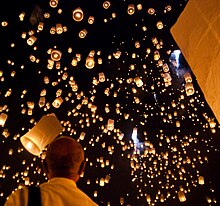
Fireworks and large rafts on the Chao Phraya River, Loi Krathong Festival of Light, Bangkok, November 2004
"Loi" means "to float" and a "krathong" is traditionally made from a section of banana tree trunk. Modern krathongs are more often made of bread or styrofoam. A bread krathong will disintegrate in a few a days and be eaten by fish and other animals. The traditional banana stalk krathongs are also biodegradable, but styrofoam krathongs are frowned on, since they are polluting and may take years to disappear. Regardless of the composition, a krathong will be decorated with elaborately-folded banana leaves, flowers, candles and incense sticks. A low value coin is sometimes included as an offering to the river spirits.
During the night of the full moon, Thais will float their krathong on a river, canal or a pond lake. The festival is believed to originate in an ancient practice of paying respect to the spirit of the waters. Today it is simply a time to have fun.
Governmental offices, corporations and other organizations usually create big decorated rafts. There are also local and officially organised raft competitions, regarding its beauty and craftsmanship. In addition, there are also fireworks and beauty contests during the celebration of the festival.
The origins of Loi Krathong are stated to be in Sukhothai, but recently scholars have argued that it is in fact an invention from the Bangkok period.[1] According to the writings of H.M. King Rama IV in 1863, the originally Brahmanical festival was adapted by Buddhists in Thailand as a ceremony to honour the original Buddha, Siddhartha Guatama. Apart from venerating the Buddha with light (the candle on the raft), the act of floating away the candle raft is symbolic of letting go of all one's grudges, anger and defilements, so that one can start life afresh on a better foot. People will also cut their fingernails and hair and add them to the raft as a symbol of letting go of the bad parts of oneself. Many Thai believe that floating a raft will bring good luck, and they do it to honor and thank the Goddess of Water, Phra Mae Khongkha (Thai: พระแม่คงคา).
The beauty contests that accompany the festival are known as "Nopphamat Queen Contests". According to legend, Nang Nopphamat (Thai: นางนพมาศ; alternatively spelled as "Noppamas" or "Nopamas") was a consort of the Sukothai king Loethai (14th century) and she had been the first to float a decorated raft. However, this is a new story which was invented during the first part of the 19th century. There is no evidence that a Nang Nopphamat ever existed. Instead it is a matter of fact that a woman of this name was instead the leading character of a novel released during the end of the reign of King Rama III – around 1850. Her character was written as guidance for all women who wished to become civil servants.
Kelantan in Malaysia also celebrates the same celebration, especially in the Tumpat area. The ministry in charge of tourism in Malaysia recognises it as an attraction for tourists. Many people visit the celebration each year.
[edit] Yi Peng

Thousands of Khom Fai in Mae Cho, Chiang Mai





















Tiada ulasan:
Catat Ulasan